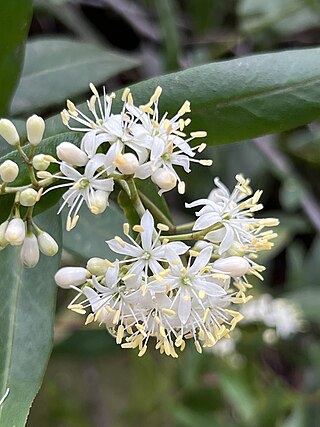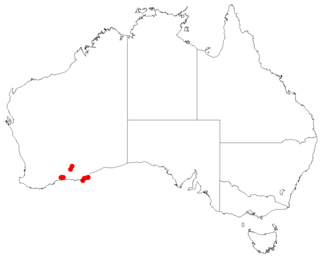
Leionema ambiens is a rare shrub growing in the Guyra district of New South Wales and Queensland, Australia. It has long stem clasping leaves and heads of white flowers in spring and early summer.

Phaleria clerodendron, commonly known as scented daphne, scented phaleria or rosy apple, is an evergreen tree or tall shrub in the family Thymelaeaceae. It is endemic to the rainforests of north-eastern Queensland, Australia.

Thryptomene baeckeacea is a species of flowering plant in the family Myrtaceae and is endemic to Western Australia. It is a shrub that typically grows to a height of 0.2–1.2 m and produces white, pink or purple flowers between May and October in the species' native range. It was first formally described in 1864 by Ferdinand von Mueller in Fragmenta phytographiae Australiae from specimens collected by Augustus Oldfield near the Murchison River.

Persoonia acicularis is a species of flowering plant in the family Proteaceae and is endemic to the west coast of Western Australia. It is a shrub with linear, sharply-pointed leaves and yellow flowers in groups of up to eighty.
Persoonia brachystylis is a species of flowering plant in the family Proteaceae and is endemic to a restricted area on the west coast of Western Australia. It is an erect, spreading shrub with smooth bark, narrow spatula-shaped to lance-shaped leaves and yellow flowers in groups of ten to twenty.

Grevillea pityophylla is a species of flowering plant in the family Proteaceae and is endemic to inland areas of Western Australia. It is a dense shrub with linear to more or less cylindrical leaves and hairy, pinkish-red to bright red flowers.

Cyanothamnus baeckeaceus is a plant in the citrus family, Rutaceae and is endemic to eastern Australia. It is a slender or straggling shrub with simple or trifoliate leaves and pink and white four-petalled flowers. It is endemic to the south-west of Western Australia.

Cyanothamnus defoliatus is a plant in the citrus family, Rutaceae and is endemic to the south-west of Western Australia. It is a straggly shrub with simple, thread-like leaves and white to pink, four-petalled flowers that are pale blue on the back.

Newcastelia cephalantha is a species of plant belonging to the mint family, Lamiaceae, and native to several Australian states: Queensland, South Australia, Western Australia and the Northern Territory

Leucopogon plumuliflorus is a species of flowering plant in the heath family Ericaceae and is endemic to the south-west of Western Australia. It is a weakly erect shrub with egg-shaped leaves and spikes of white or pinkish-white, tube-shaped flowers.

Ptilotus divaricatus is a shrub in the Amaranthaceae family.

Coopernookia strophiolata is a shrub in the Goodeniaceae family, endemic to Australia and found in both Western Australia and South Australia.

Pembertonia latisquamea is a species of daisy (Asteraceae), native to Western Australia. It was first described by Ferdinand von Mueller in 1878 as Brachyscome latisquamea and transferred to the genus, Pembertonia in 2004 by Philip Short.
Pomaderris grandis, commonly known as large pomaderris, is a species of flowering plant in the family Rhamnaceae and is endemic to a restricted part of the south-west of Western Australia. It is an erect shrub that typically grows to a height of 30–75 cm (12–30 in) and produces white flowers from July to October. It grows in rocky gullies on the slopes of Mount Manypeaks in the Esperance Plains biogeographic region of south-western Western Australia. The species was first formally described in 1862 by Ferdinand von Mueller in his Fragmenta Phytographiae Australiae. It is listed as "Priority Four" by the Government of Western Australia Department of Biodiversity, Conservation and Attractions, meaning that it is rare or near threatened.

Leucopogon bossiaea is a species of flowering plant in the heath family Ericaceae and is endemic to a restricted area in the south-west of Western Australia. It is an erect shrub with elliptic to broadly egg-shaped leaves and white flowers in four to eleven upper leaf axils.

Styphelia allittii is a species of flowering plant in the family Ericaceae and is endemic to the south-west of Western Australia. It is a rigid, glabrous shrub that typically grows to a height of about 30 cm (12 in) and has egg-shaped or lance-shaped leaves and tube-shaped, white flowers.

Leucopogon breviflorus is a species of flowering plant in the heath family Ericaceae and is endemic to the south-west of Western Australia. It is an erect, spindly, glabrous shrub that typically grows to a height of up to about 1.5 m. It has oblong to lance-shaped or linear leaves 4–9 mm (0.16–0.35 in) long on a short petiole and with a small, rigid point on the tip. The flowers are borne singly or in pairs in leaf axils on a short peduncle with small bracts and bracteoles about half as long as the sepals. The sepals are about 2 mm (0.079 in) long and the petals white and about 4 mm (0.16 in) long, the petal lobes longer than the petal tube.

Mirbelia seorsifolia is a species of flowering plant in the family Fabaceae and is endemic to the south-west of Western Australia. It is an erect, open shrub that typically grows to a height of 15–70 cm (5.9–27.6 in) and has yellow and red flowers from August to December. It grows on sandplains in the Avon Wheatbelt, Coolgardie, Great Victoria Desert, Murchison and Yalgoo bioregions of south-western Western Australia. The species was first formally described in 1876 by Ferdinand von Mueller, who gave it the name Gastrolobium seorsifolium in Fragmenta Phytographiae Australiae. In 1943, Charles Gardner changed the name to Mirbelia seorsifolia in Enumeratio Plantarum Australiae Occidentalis. The specific epithet (seorsifolia) means "separate leaves", referring to the well-spaced leaves. Mirbelia seorsifolia is listed as "not threatened" by the Government of Western Australia Department of Biodiversity, Conservation and Attractions.

Hemigenia teretiuscula is a species of flowering plant in the family Lamiaceae and is endemic to the southwest of Western Australia. It is an upright, glabrous shrub that typically grows to a height of 10–80 cm (3.9–31.5 in), the leaves about 1 mm (0.039 in) in diameter, more or less tapering cylindrical and somewhat sharply pointed. Flowering usually occurs from August to December and the flowers are bluish-purple.

Leucopogon opponens is a species of flowering plant in the heath family Ericaceae and is endemic to the south-west of Western Australia. It is an erect, slender shrub with its leaves arranged in opposite pairs, and white, tube-shaped flowers.



















